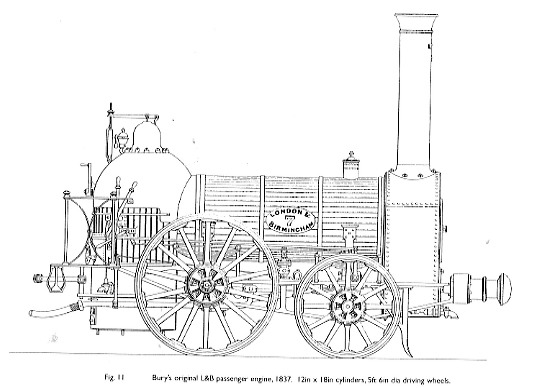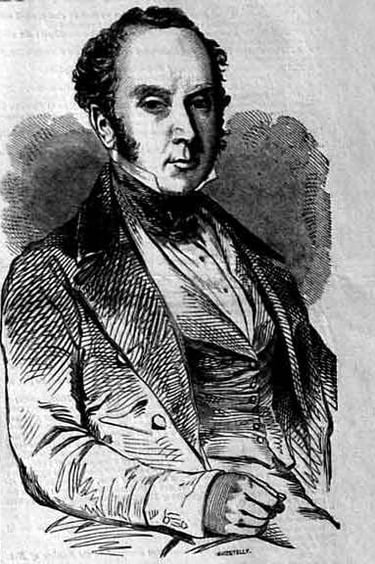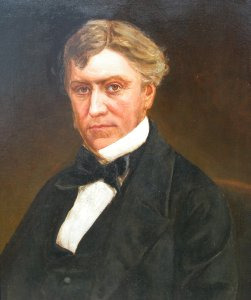

Report of the Station Sub Committee, on the accident to the Seven o’clock Up Train on Saturday the 4th Nov.
Office Euston Station, 6th Nov 1837.
The Sub Committee having examined at considerable length the several persons to whom they thought it necessary to refer for information as to the circumstances connected with the accident have to report the result of their enquiry.
The Train composed of two first class and five second class carriages was drawn by Messrs Hawthorn’s Engine No.16 in charge of George Robson, Engineer with Holmes as Fireman and Chicken the Engineer who had been sent up by Messrs Hawthorn & Co. with the new Engine, on the Tender. H. Bailey No. 47 was Guard in charge of the Train. Bailey states that the Train started from the Tring Station in proper order and at the usual time. That after leaving Berkhampstead the Engine proceeded at a speed which appeared to him so extremely dangerous that at the Boxmoor embankment, where the Road was very bad he put the Break on three times in hopes of attracting the attention of the Engineman. That the Carriages were several times nearly off the Rails, and that on the arrival of the train at Watford he expressed to Sub-Assistant Engineer Jenkins, and two of Mr. Buck’s pupils has apprehension of the consequences if they continued to move at the same speed over the bad points of the Road.
The Train Bailey added left the Harrow Station with 87 Passengers at 8 o’clock the regular time for its departure, that the Engine again proceeded, to use his own expression at a most fearful rate and that on arriving at Excavation No.12 he experienced a sudden shock which threw him on the roof of the Carriage opposite to that on which he was sitting.
That on recovering himself he observed the Engine on the opposite or right hand side of the Road near the Last Carriage of the Train and with the front towards the Harrow Station, the Tender thrown over on the slope to the left of the Line, the first Carriage also turned over and broken to pieces, the next to it on an end, and the other second class Carriages off the Rails and much damaged the two first Class Carriages, which were last n the Train without injury. The Passengers were all unhurt – and at his recommendation reseated themselves in the Carriages. That he found the Engineman George Robson lying on the ground dreadfully injured and Holmes and Chicken unhurt, but the latter in a state of intoxication.
In answer to questions of the Sub-Committee Bailey stated that in his opinion the cause of the accident was the Engine having been put to too great a speed and that having carefully examined the Rails for some distance he could find nothing to justify a suspicion that there was anything wrong with the Road or the Rails.
Mr Davis of George Street, Hanover Square, who was a passenger by the train from Boxmoor and a frequent Traveller on the Road attended the Sub-Committee and confirmed the statement of Bailey as to the dangerous and irregular speed of the Engine and added that the Engineman were not sober. His declaration on this point is entitled to the more weight from the opportunity he had of observing the men closely whilst exercising his professional skill to save Robson’s life, other witnesses have also spoken decidedly as to their state previous to the accident, Holmes the Fireman affirms that he was not at all in liquor, and it certainly appears that he was very active and useful after the occurrence. Holmes states that the up line in Excavation No.12 has long been in a bad state, that after leaving the Harrow Station he did not think the speed exceeded from 20 to 25 miles an hour (Baily estimated it at 40), that on coming to this point of the Road the Engine made several pitches accompanied with a considerable swaying, that the Steam was then shut off by Robson who stood on the platform and that he fell at the instant the Buffers of the Train came violently against the Tender, that he has no recollection of what followed till he found himself lying on the ground with the Tender turned over him.
Mr Fox stated that in Excavation No.12, the Rails were laid on Sleepers in consequence of the wetness of the ground but that within the last fortnight it has been thoroughly drained, that the Road on this part of the Line is now in excellent condition and that he had specially called Mr Stephenson’s attention to its improved state on Friday.
That the Rails had been carefully examined and ascertained to be strictly in guage [sic] and that nothing was found near them which could have caused an obstruction to the Train facts which were fully corroborated by Mr Bagster who was on the spot with Mr Fox before any of the carriage had been removed.
Mr Andrews on the other stated to the Sub-Committee that the Rails were not in good condition at the place where the Engine was thrown off but his remarks on this head did not appear entitled to any weight in opposition to the distinct testimony of Mr Fox and Mr Bagster and to the result of the careful inspection and guage of the Rails immediately after the accident, because his examination was avowedly limited to the immediate sport where the Engine was thrown off and where the Rails had been necessarily injured and displaced.
The state of the Engine before it was sent out and afters its return, as reported by Mr Andrews and confirmed by Mr Fox is sufficient to prove that it was in good condition and that although the axles and other parts of the machinery are much injured and the Carriage destroyed, the Boiler is perfectly sound.
In the absence, therefore, of any distinct evidence as to the immediate cause of the occurrence the Sub-Committee called upon Mr Fox to state his opinions on it.
Mr Fox observed in reply that the Engine running at a great speed would in passing over any slight unevenness of obstacle (too small to be of consequence at a less velocity, acquire a jumping or rather pitching motion and if several of these jumps came in succession it is probably that the Engineman would if alarmed shut off the steam instantaneously; upon this the speed of the Engine would be suddenly checked and the buffers of the first Carriage coming forcibly in contact with the Buffers of the Tender would cause the Engine to received a blow which would urge it forward with great violence. – As the blow could only be transmitted to the Engine through the central draw by bolt and as the Engine and Tender were swinging from side to side at the time it is difficult to believe that the blow would be given in the directions of the centre of the engine but rather diagonally.
If therefore the blow were given diagonally at the moment the fore wheels of the engine were raised from the Rail in the act of jumping it would force or rather kick the Engine off the line.
The view which Mr Fox has taken of the case is supported by the facts which were elicited by the Sub-Committee in the course of there [sic] investigation particularly in the examination of Holmes the fireman and they appear to warrant the inference that the speed of the Engine was irregular and that the Engineman was not in a condition to exercise a sound discretion in regulating it.
From the report of Mr Bagster to the Sub-Committee it appears that in conformity with Mr Bury’s instructions, Mr Andrews sent out an Engine on the Down Line when he found that the secn o=Clock Train was a quarter of an hour after time. - That the Engine arrived in Excavation No.12 at Ten o’Clock and was immediately sent back for a Train of Carriages.
That it carriage a Train from the Euston Station with Mr Fox and Mr Bagster at Eleven o’Clock, that about 20 minutes was occupied in shifting the Passengers, and that they arrived at one o’Clock at the Euston Station.
Mr Fox and Mr Bagster remained on the ground until the broken Engine and Carriages were all removed and the permanent way completely restored, and until they were satisfied that no obstacle existed to the passage of the Trains.
The Sub-Committee on the mature consideration of the various circumstances which have been brought under their notice in the course of the present investigation are decidedly of opinion, looking to the importance of the trust which is confided to the Enginemen, that precautionary measures should be taken for securing the Passengers and the property of the Company from the possibility of his not being in a fit state for the exercise of so important a change, and they recommend accordingly that a system of superintendence in this department should be adopted in concert with Mr bury as early as possible.
They are of opinion also that the average speed of the Engines should be so regulated, especially in the dark, that there should be no excuse for carrying it beyond that rate which may be deemed consistent with the perfect safety of the Trains.
The Sub-Committee have given orders that every Engine which is sent on the Lind when a Train is after time shall take with it four of the late Second Class Carriages to be ready for use in case of need.
The Sub=Committee cannot conclude their report without adverting specially to the excellent conduct of Bailey the Guard under very trying circumstances and to the unremitting exertions of Mr fox and Mr Bagster in their respective departments and they have the pleasure to add that Mr Bagster reported most favourably as to the conduct and exertions of the Ports and Policemen who attended through the night.
The Sub-Committee beg to remark that although Mr Davis’s remarks applied to the man on the Engine yet the fact regards Holmes not having been confirmed by other witnesses and his general character being very good, it is not wished to press this part of the report against him,
The Sub-Committee have to submit the claim of Mr Davis to the best thanks of the Company for his humane attention to the Engineman and his kindness in attending the Sub-Committee.
G.C. Glynn
Mr Fox
Robert Stephenson appointed him as one of the engineers on the London and Birmingham Railway, where he was responsible for Watford tunnel and the incline down from Camden Town to Euston. As an Engineer Fox had a range of duties as can be seen here in this report. It also appears, according to the minutes of the company, that he was the first to design a Travelling Post Office or TPO. One of his earliest inventions, patented in 1838, were railway points, which superseded the sliding rail used up to that time. He presented an important paper on the correct principles of skew arches to the Royal Institution.
Fox then entered into partnership with the contractor Francis Braham to form the company Braham, Fox and Co., which amongst other things was contracted to build carriages for the Manchester & Leeds Railway. When Braham retired the company became Fox, Henderson and Co., of London, Smethwick, and Renfrew. The company specialised in railway equipment, including wheels, bridges, roofs, cranes, tanks and permanent way materials. It also experimented with components for suspension and girder bridges. They also provided the rooves of Euston and Birmingham Train sheds. Later also Liverpool Tithebarn Street, (1849–50), Bradford Exchange (1850), Paddington and Birmingham New Street.
Fox and Henderson's expertise with structural ironwork led Joseph Paxton to invite them to build The Crystal Palace for the Great Exhibition of 1851. Because of its innovative modular design and construction techniques, it was ready in nine months. For their work, Fox, Cubitt and Paxton were knighted on 23 October 1851. After the exhibition they were employed by the Crystal Palace Company to move the structure to Sydenham, re-erecting and enlarging it on Sydenham Hill, thereafter known as Crystal Palace.
George Glynn
The writer of this report is George Car Glynn, in 1836 Glyn he became Chairman of the North Midland Railway, and in 1837 the second Chairman of the London and Birmingham Railway. In 1841 he resigned his Chairmanship of the North Midland, but remained a director. Glyn and his bank were important in the development of the railways. By the 1850s, over 200 railway companies, both domestic and foreign, banked with Glyn, Mills, and Co.
In 1842, he founded the Railway Clearing House, an organization that helped determine payments by companies that operated trains to the many different companies that owned connecting tracks. In 1846, when the London and North Western Railway was formed, he was its Chairman until 1852. Glyn's bank served as one of the London agents for the provincial government of Canada, and in 1852 he was a promoter of the Grand Trunk Railway. He was the first President of The Railway Benevolent Society, upon its creation, at a meeting at the London Tavern, on 8 May 1858. George presided at this meeting and gave a speech outlining his aims for this society: The first aim was to benefit the widow and orphan. The second aim was to educate the child. A resolution was carried unanimously, at that meeting, stating that the society should be called the Railway Benevolent Institution.


Engine No.16
Harry Jack dates No. 16 as July 1837, but delivery as indicated by this report, would appear to have been later, perhaps even November. Despite the extensive damage the loco suffered in this accident, it appears that frame was smashed, the engine must have been rebuilt since it was rebuilt again in June of 1843, according to Harry Jack. Its luck was poor however being one of the first Bury’s to be scrapped after yet another accident in 1847.




The Hawthorn accident 1837
